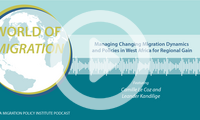Employment & the Economy
Recent Activity

This webinar examines the challenges that refugees and other migrants face in—and place on—secondary cities, municipal capacity to respond to needs, the types of support required at national and other levels, and how development actors can better partner with secondary cities and local actors.

MPI Europe Associate Director Camille Le Coz discusses migration dynamics in West Africa and and how African leaders are responding to these trends with Leander Kandilige, a senior lecturer at the Centre for Migration Studies at the University of Ghana.

Marking release of a report, experts on this webinar examine migration narratives since 2018 and how they have been used to justify policy approaches or incentivize mobility decisions.

This webinar, marking the launch of a report, looks at career and technical education programs and federal, state, and school district policies that support English Learners' inclusion in these programs.
Marking the launch of MPI’s Global Skills and Talent Initiative, this webcast features senior policymakers and other experts discussing the extent to which labor market needs should shape future immigration policy decisions, and how countries are adjusting—and could adjust—their immigration systems to meet human capital and competitiveness needs.
Pages
Recent Activity
Some of the strictest COVID-19 pandemic-era limits on human mobility occurred in the Asia Pacific region. Border closures started in East and Southeast Asia in early 2020 and quickly spread through the entire region, in some cases remaining in place for more than two years. This report examines the approaches countries took and reflects on the immense costs and benefits of using border measures to tackle public-health risks.
The COVID-19 pandemic’s impacts on mobility in the Middle East and North Africa were immediate and wide-reaching. These include the world’s largest and most sustained repatriation efforts for stranded migrants, halted and reversed irregular journeys, and a reckoning with some countries’ reliance on foreign labor. This report examines how these impacts varied across countries in this highly diverse region, as well as the uneven recovery.
The COVID-19 pandemic hit South American nations at a time when many were already contending with major migration challenges. Historic levels of intraregional migration and displacement, notably from Venezuela, collided with countries’ attempts to stop the spread of a new threat to public health. This report examines the region’s responses to the public-health crisis, and the immediate and lasting impacts on cross-border movement.























As Europe and the United States Face Similar Migration Challenges, Spain Can Act as a Bridge